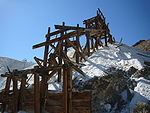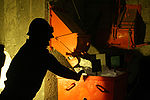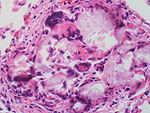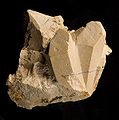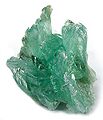Talc
| Talc | |
|---|---|

| |
| General | |
| Systematic name | Oxobismuth Hydrochloride |
| Other names |
Kerolite |
| Molecular formula | Mg 3(Si4O10)(OH)2 |
| Percent Composition |
4.8% H2O |
| Molar mass | Molar mass:: |
| Appearance |
Sea Green |
| CAS number | CAS number::14807-96-6 |
| Properties | |
| Density and phase | Density:: 2.58 g/ml |
| Melting point | Melting point::800°C |
| Structure | |
| Molecular shape | Triclinic |
| Coordination geometry| | |
| Crystal structure | Monoclinic 2/m |
| Chemical Structure of Talc | |
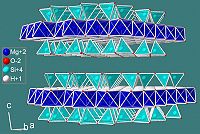
| |
| Except where noted otherwise, data are given for materials in their standard state (at 25 °C, 100 kPa) Disclaimer and references | |
Talc is a mineral also known as Kerolite, Magnesium Talc, and Soapstone. [1] It is a hydrated form of Magnesium Silicate that is most widely known for it's use in talcum powder, also known as baby powder.
The word talc comes from the greek and Arabic term “talq” which means pure. [2]
Properties
Talc is a broad term that includes many different types of minerals and is a hydrous from of magnesium silicate.[3] Talc is a very soft mineral and can be scratched into with a fingernail. [4] It also has a sea green and white color with white streaks. It is a beautiful mineral and has a diaphaneity that is translucent and a hardness level of 1. The specific gravity, the density of a substance divided by the density of water, is about 2.7. [5]. It is not shiny, but has a silky or waxy look. It is not magnetic and has perfect cleavage, meaning that if broken, it breaks off clean. When whole, the ore can be many different colors, such as white, green, or brown. When crushed, it becomes a fine white powder used in many products worldwide.[4][6] Talc is a soapstone, it may feel “slippery” or “greasy.” Talc is also known to be a very flexible mineral. Talc’s crystal structure is called a bructite sheet between two SiO2 sheets held together by Van Der Waals forces. These forces are easily broken by friction. All of the sheets of SiO2 are neutral, so they remain together. [3]
Occurrences
Large Talc mines are found in countries such as Germany, Austria, South Africa, Scotland, Italy, France, and Canada. It is also found in the United States in California, Texas, Georgia, and Montana. Talc is usually found with magnesium rich materials and has been found up to 66 feet down. [7] Fibrous magnesium silicate contains tremolite, anthophyllite, and serpentine and is harder and more difficult to grind. [8]The non-fibrous talc (pure talc) contains carbonates and serpentine and quartz. Massive talc, also known as soapstone, has three main parts: magnesite, dolomite, chlorite. Magnesium silicate in it’s massive form is used in many ways such as a colorant, sculpting, and for science countertops and lining pizza ovens because of it’s high heat tolerance. [9] Talc is not found alone, but instead can be thin and vein like, passing through magnesium rich rocks and minerals such as anthophyllite, dipside, tremolite, dolomite, calcite, and quartz. The veins can range from thin and string-like to 25 to 40 meters by 18 meters. [10]
Uses
Talc is most commonly known for being used to heal rashes, such as in baby powder. It is also used very often in everyday materials such as crayons, soap, certain paints, paper, and is also used in pharmacies for making medications [11] because it can becut into any size or powdered down for manufacturing uses. [12]
Potstone is a more contaminated form of talc that is for pottery such as vases and pots. Talc is also used for a pottery technique called crazing.
French chalk, also called french talc, is finely crushed chalk used for removing grease stains and for makeup and other cosmetics such as baby powder. French Chalk is also used for marking fabrics for sewing.
[13]
[14]
Talc can also be found in heroin, a drug taken from the poppy flower. [15] Sometimes heroin is cut, meaning another substance is added to make it appear to be in a greater quantity, with talc. The difference is unnoticeable by the naked eye and increases heroin’s street value. Most morphine sold to illegal heroin manufactures is cut with talc and not the “china white” the laboratories desire.” As the heroin appears to be thicker, it also thickens the users blood. [16]
Health and Safety
After the 1970’s, talcum powder has been asbestos free and gives no health risks, but before that, the powder contained asbestos. When rubbed on women’s genitails it was known to cause ovarian cancer due to low inflammation. Another study showed that women who uses Talcum Powder have a lower antibody count. Cite error: Invalid <ref> tag; invalid names, e.g. too many
Talc is toxic and is also known to cause tumors in the lungs. Thousands of babies have passed away because of inhalation of baby powders. The FDA was planning on making a law that would cause a restriction on the amount of asbestos allowed in talcum powder, but it was never put into effect [17] Talc use once a week increased cancer risk 36 per cent and this number rose to 41 per cent for those using talcum powder daily.[18] Talc has also been linked in many studies to a lung disease called Talcosis and to silicosis [19]
Although most parents have switched to ointments, Baby powder can be dangerous to children because of the extremely small particles that fly in the air like dust and can reach the lungs. inhalation of talcum powder can cause pneumonia, inflammation of the airways of babies, and even death.[20]
Minerals
Gallery
References
- ↑ Webmineral.com Webmineral.com
- ↑ Talc Author Unknown, The Mineralogical Society. Accessed April 1, 2011.
- ↑ 3.0 3.1 SpecialtyMinerals.com
- ↑ 4.0 4.1 Talc Pellant, Chris. Rocks and Minerals. New York: Dorling Kindersley, 1992
- ↑ Talc is unique and distinguishable because of its waxy feel, sea green color, extreme softness, and perfect cleavage. Geology.com © 2005-2011 Geology.com
- ↑ Galleries.com Amethyst Galleries Inc, 1995-2011
- ↑ [1] Copyright © Mineralszone.com 2005
- ↑ Gold Prospecting.com
- ↑ Talc Toxology Edouard Bastarache M.D., Accessed 2/15/11, Digitafire.com
- ↑ Physical Properties of Talc Mineral e-goldprospecting.com, Author Unknown
- ↑ [2] Cancer Prevention Coalition, Copyright 2003,
- ↑ Physical Properties of Talc Mineral e-goldprospecting.com, Author Unknown
- ↑ French chalk The American Heritage® Dictionary of the English Language, Fourth Edition, Accessed 2/15/11
- ↑ Gold Prospecting.com
- ↑ Drug Addict’s Lung Clinical Atlas of Interstitial Lung Disease, Accessed 2/15/11
- ↑ Don’tMarrytheDragon.org don’tmarrythedragon.org, author unknown
- ↑ Risks of Talcum Powder PreventCancer.com
- ↑ Cancer alert over talc: Women using powder every day 'are at risk' Dailymail.com, Pat Hagan, 1:11 AM on 27th September 2008
- ↑ Definition of Talc Medterms.com ,4/19/2000 2:35:00 PM
- ↑ Is Talcum Powder Safe For Babies? ivillage.com, Jan 1, 1999, Robert Steele
| ||||||||||||||
